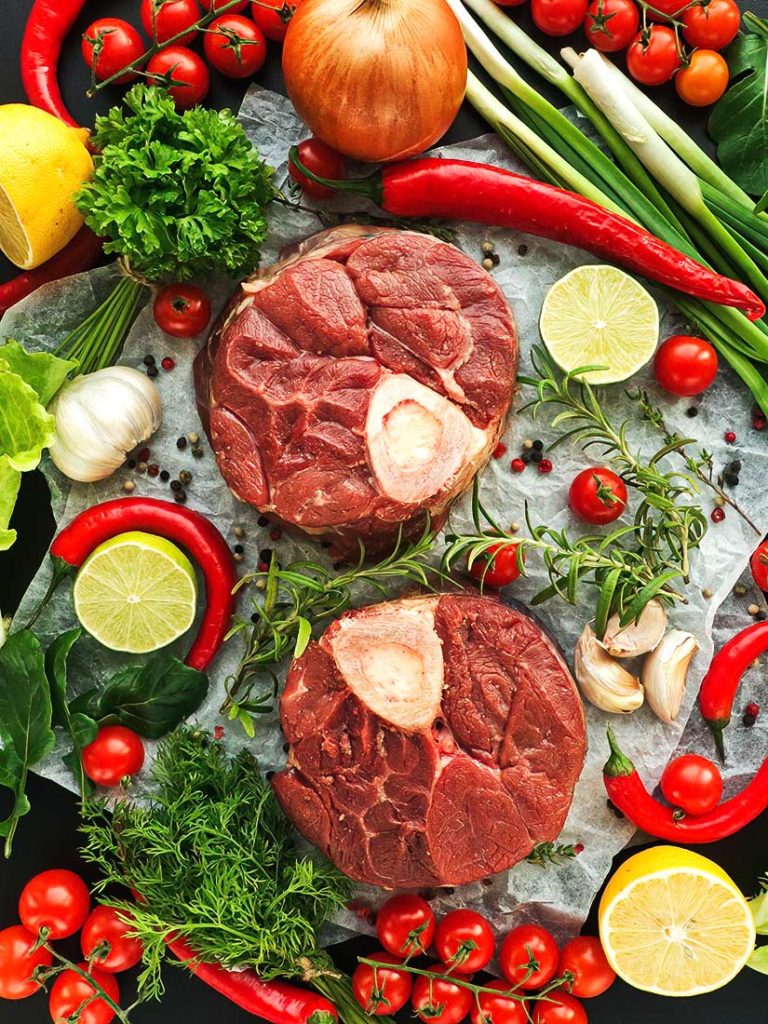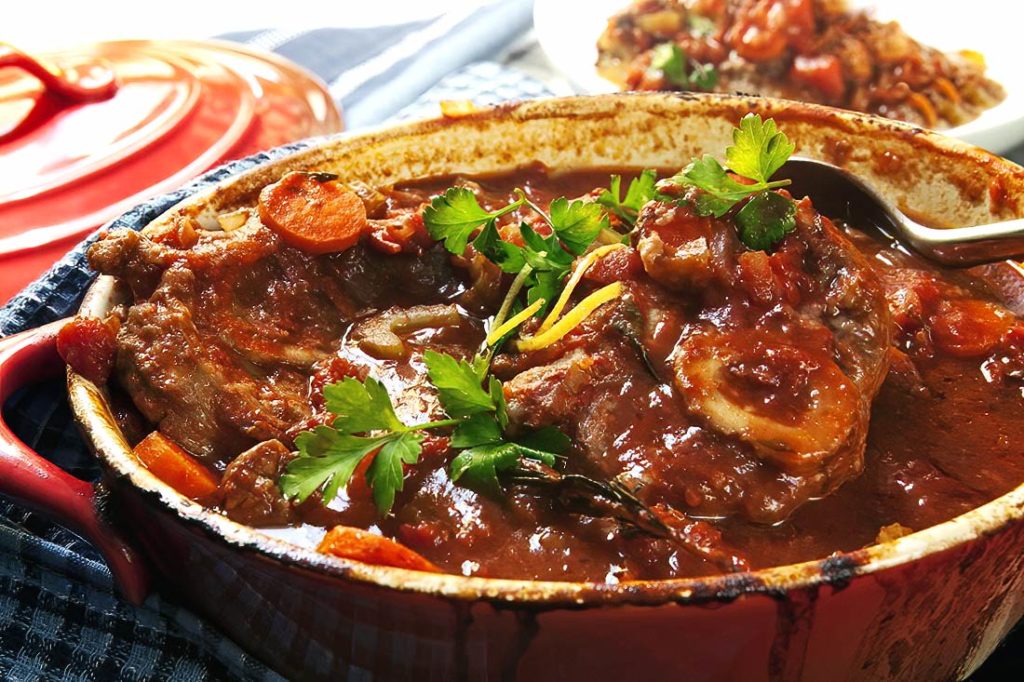Osso Buco is a comforting Italian dish where tender veal shanks are slowly braised in a rich tomato-based sauce with carrots, celery, and onions. The dish is traditionally served with a gremolata topping, adding a fresh, zesty contrast to the meaty flavors.
Preparation Time
- Prep Time: 25 minutes
- Cook Time: 2 hours
- Total Time: 2 hours 25 minutes
Ingredients (For Four People)
- 4 veal shanks (about 1.5 to 2 inches thick)
- 2 tablespoons olive oil
- 1 large onion, diced
- 2 medium carrots, sliced
- 2 stalks celery, chopped
- 4 cloves garlic, minced
- 1 cup dry white wine
- 1 cup chicken or beef broth
- 1 can (14 oz) crushed tomatoes
- 1 tablespoon tomato paste
- 1 teaspoon dried thyme
- 1 teaspoon dried rosemary
- 2 bay leaves
- Salt and pepper to taste
- 1 lemon (zest only, for garnish)
- Fresh parsley (for garnish)
1 tablespoon is circa 15 ml, and a teaspoon is circa 5 ml.
Preparation Method
Step 1: Prep the veal shanks
Pat the veal shanks dry with paper towels and season them generously with salt and pepper. Lightly dredge them in flour, shaking off any excess.
Step 2: Sear the veal
Heat the olive oil in a large Dutch oven or heavy-bottomed pot over medium-high heat. Add the veal shanks and sear on all sides until browned about 8 minutes. Remove the shanks from the pot and set them aside.
Step 3: Cook the vegetables
In the same pot, add the onions, carrots, and celery. Sauté for 5-7 minutes until the vegetables begin to soften. Add the garlic and cook for another 1-2 minutes until fragrant.
Step 4: Deglaze with wine
Pour in the white wine, scraping up any browned bits from the bottom of the pot. Let the wine reduce by half, about 5 minutes.
Step 5: Add liquids and seasonings
Stir in the tomato paste, crushed tomatoes, chicken broth, thyme, rosemary, and bay leaves. Bring the mixture to a simmer.
Step 6: Braise the veal
Return the seared veal shanks to the pot, ensuring they are partially submerged in the liquid. Reduce the heat to low, cover, and let the mixture simmer gently for 1.5 to 2 hours, or until the veal is fork-tender and the sauce has thickened.
Step 7: Garnish and serve
Before serving, zest a lemon over the osso buco and sprinkle with fresh parsley. Serve with risotto, polenta, or mashed potatoes.

Tips and Tricks
- You can substitute beef broth with veal broth for extra depth of flavor.
- If the sauce reduces too much while cooking, add more broth to maintain the sauce’s consistency.
Serving Suggestions
Pair the Osso Buco with creamy polenta or risotto alla Milanese for an authentic Italian experience. Garnish with fresh parsley and lemon zest to brighten the rich flavors.

Wine Pairing
- Typical Wine: Pair with a full-bodied red wine like Barolo or Chianti.
- Bulgarian Wine: A rich Mavrud would complement the flavors of the veal and vegetables.
Nutritional Information (Per Serving)
- Calories: 520
- Protein: 46g
- Fat: 22g
- Carbohydrates: 26g
Dietary Modifications
- Gluten-Free: Use gluten-free flour to dredge the veal.
- Dairy-Free: This dish is naturally dairy-free, but avoid pairing it with butter-based sides.
Storage Suggestions
Refrigerating: Store leftover Osso Buco in an airtight container in the refrigerator for up to 3 days. Be sure to let the dish cool completely before sealing and storing.
Freezing: Osso Buco freezes well. Please place it in a freezer-safe container, leaving some space at the top for expansion. It will keep for up to 3 months. To reheat, allow it to thaw overnight in the refrigerator before reheating.
Reheating: For best results, reheat Osso Buco gently on the stovetop over low heat until warmed through. You may need to add a splash of broth or water to prevent the sauce from becoming too thick. Alternatively, you can reheat it in the microwave in 1-2 minute intervals, stirring occasionally.
About the Dish
Osso Buco, which translates to “bone with a hole”, refers to the central bone marrow within the veal shank that adds richness and depth to the dish as it cooks. Originating from the Lombardy region of northern Italy, mainly from Milan, Osso Buco was traditionally a dish of the working class, as braising inexpensive cuts of meat like veal shanks was an affordable way to create a hearty meal. The slow braising process breaks down the tough connective tissues, resulting in tender, melt-in-your-mouth meat. As the shanks cook in a combination of wine, broth, and vegetables, the flavors meld together, creating an intensely flavorful sauce. The rustic and robust dish makes it a favorite during colder months, especially as a winter comfort food.
Modern variations of Osso Buco may include meats like pork or beef, but the classic version is always veal. In some regions, the dish is finished with gremolata, a zesty topping of lemon zest, garlic, and parsley, adding freshness to balance the sauce’s and meat’s richness.
Cultural Context
Osso Buco is a beloved dish in Italian cuisine and is often reserved for special occasions, such as family gatherings, festive celebrations, or Sunday dinners. In Lombardy, Osso Buco is traditionally served with Risotto alla Milanese, a saffron-infused risotto that complements the dish’s rich, braised flavors. This combination highlights the Milanese love for using luxurious ingredients like saffron and marrow in their cuisine.
Over the years, Osso Buco has become a symbol of Italian hospitality and home cooking, as it brings people together around the table to enjoy a communal meal. The preparation of Osso Buco requires patience and care, making it a dish often prepared for loved ones to celebrate family and tradition. Adding gremolata at the end of the cooking process provides a fresh, fragrant contrast to the rich flavors, reflecting the Italian philosophy of balancing dishes with indulgent and fresh elements. This finishing touch and its tender texture have earned Osso Buco its reputation as a quintessential comfort food in Italy and beyond.
Osso Buco remains an enduring classic in Italian cuisine. It demonstrates the art of slow cooking and transforming simple ingredients into something extraordinary.


